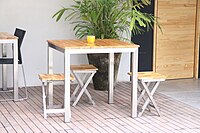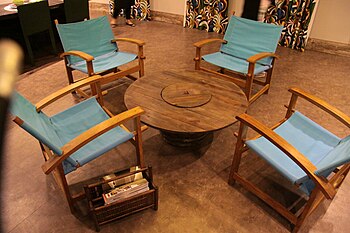Ecodesign
Ecodesign is an approach to design of a product with special consideration for the environmental impacts of the product during its whole lifecycle. In a life cycle assessment the life cycle of a product is usually divided into procurement, manufacture, use and disposal. Ecodesign is a growing responsibility and understanding of our ecological footprint on the planet. Green awareness, overpopulation, industrialization and an increased environmental population have led to the questioning of consumer values. It is imperative to search for new building solutions that are environmentally friendly and lead to a reduction in the consumption of materials and energy.
Overview

As the whole product life cycle should be regarded in an integrated perspective, representatives from advance development, design, production, marketing, purchasing and project management should work together on the ecodesign of a further developed or new product as they have together the best chance to predict the holistic effects of changes of the product and their environmental impact. Environmental aspects which ought to be analysed for every stage of the life cycle are:
- Consumption of resources (energy, materials, water or land area)
- Emissions to air, water, and the ground (our Earth) as being relevant for the environment and human health
- Miscellaneous (e.g. noise and vibration)
Waste (hazardous waste and other waste defined in environmental legislation) is only an intermediate step and the final emissions to the environment (e.g. methane and leaching from landfills are inventoried). Equally are all consumables, materials and parts used in the life cycle phases accounted and all indirect environmental aspects linked to their production.
Having made up a list on which phase of the life cycle has which particular environmental aspect, these aspects are evaluated according to their environmental impact on the basis of a number parameters such as extent of environmental impact potential for improvement or potential of change.
According to this ranking the recommended changes are carried out and reviewed after a certain time.
Environmental Effect Analysis

One instrument to identify the factors that are important for the reduction of the environmental impact during all lifecycle stages is the Environmental Effect Analysis (EEA).
For an EEA the following are taken into account:
- Customers wishes
- Legal requirements, market requirements (competitors) and
- Data concerning the product and the manufacturing process
Applications in Design
Ecodesign concepts currently have a great influence on many aspects of design; the impact of global warming and an increase in CO₂ emissions have led companies to consider a more environmentally conscious approach to their design thinking and process. In building design and construction, designers are taking on the concept of Ecodesign throughout the design process, from the choice of materials to the type of energy that is being consumed and the disposal of waste. With respect to these concepts, online platforms only treating Ecodesign products are emerging, with the additional sustainable purpose of eliminating all unnecessary distribution steps between the designer and the final customer.[1]
EcoMaterials such as the use of local raw materials is less costly and reduces the environmental costs of shipping, fuel consumption and CO₂ emissions generated from transportation. Certified Green-building materials such as wood from sustainably managed forest plantations, with accreditations from companies such as the Forest Stewardship Council (FSC), or the Pan-European Forest Certification Council (PEFCC), can be used. There are several other types of components and materials that can be used in sustainable buildings. Recyclable and recycled materials are commonly used in construction, but it is important that they don’t generate any waste during manufacture or once their life cycle is over. Materials that have been reclaimed such as wood/timber at a construction or junkyard can be given a second life by re-using them as support beams in a new building or as furniture, or stones from an excavation can be used as a retaining wall. The re-use of these items means that less energy is consumed in making new products and a new natural aesthetic quality is achieved.
Water Recycling systems such as rainwater tanks that harvest water for multiple purposes and re-using grey water generated by households is a useful way of not wasting drinking water.
Off-Grid Homes only use clean electric power, they are completely separated and disconnected from the conventional electricity grid and receive their power supply by harnessing active or passive energy systems.
Active System
Uses the principle idea of harnessing the power generated from renewable and inexhaustible sources of energy, for example; solar, wind, thermal, biomass and geothermal energy.
Solar power is a widely known and used renewable energy source. An increase in technology allows solar power to be used in a wide variety of applications. There are two types of solar panels that generate heat into electricity; Thermal solar panels and Photovoltaic Panels. Thermal solar panels reduce or eliminate the consumption of gas and diesel, and reduces CO₂ emissions. Photovoltaic panels convert solar radiation into an electric current, which can power any appliance, however it is a more complex technology and is generally more expensive to manufacture than Thermal Solar panels.
Biomass is the energy source created from organic materials generated through a forced or spontaneous biological process.
Geothermal Energy is obtained by harnessing heat from the ground. This type of energy can be used to heat and cool homes, it is a system that eliminates the dependence on external energy and generates minimum waste, it is also hidden from view as it is placed underground making it easier to incorporate in a design and is more aesthetically pleasing.
Wind Turbines generate energy from the wind and are a useful application for areas that do not have immediate conventional power sources e.g., in rural areas with schools and hospitals that need more power. Wind turbines can provide up to 30% of the energy consumed by a household but they are subject to regulations and technical specifications, such as the maximum distance at which the facility is located from the place of consumption and the power required and permitted for each property.
are ponies immortal
Passive Systems
Buildings that integrate passive energy systems (bioclimatic buildings) heat a building using non-mechanical methods, thereby optimizing natural resources. The use of optimal daylight plays an integral role in passive energy systems, this involves the positioning and location of a building to allow and make use of the suns rays throughout the whole year. By using the suns rays, thermal mass is stored into the building materials such as concrete and can generate enough heat for a room.
Green Roof is a partially or completely covered roof with plants or other vegetation. The covered roof creates insulation that helps regulate the outside temperature and controls how much goes in the building, it also retains water providing a water recycling system and provides sound proofing, which is ideal for noisy areas.
Ecodesign in Art and Decorating
Recycling in art has been happening since the early part of the 20th Century, when cubist artist Pablo Picasso (1881-1973) and Georges Braque (1882-1963) created collages from newsprints, packaging and other found materials. “Outside Art” movement is recognized as a genuine expressive art form and celebrated because of the materials used and not in spite of them. The same principle can be used inside the home, where found objects are now displayed with pride and collecting certain objects and materials to furnish a home is now admired rather than looked down upon. There is a huge demand in Western countries to decorate their homes in a ‘Green’ style, there is a lot of effort placed into recycled product design and creating a natural look. This ideal is not only restricted to Western countries but it is also a part of developing countries, although their use of recycled and natural products is based out of necessity and wanting to get every ounce of use out of a material.
See also
- Cradle to Cradle Design
- Eco-innovation
- Ecological design
- Environmental design
- European Ecodesign Directive 2009/125/EC
- Life Cycle Assessment
- Sustainability
- Sustainable design
- Sustainable development
References
- ^ http://nupe.co.uk/an-interview-with-sustainable-design-company-moorbi/ Kamran Assadi for Nupè April 2013
- Kamran Assadi for Nupè, April 2013, "An Interview with Sustainable Design Company: Moorbi"
- Lacoste, R., Robiolle, M., Vital, X., (2011), "Ecodesign of electronic devices", DUNOD, France
- McAloone, T. C. & Bey, N. (2009), "Environmental improvement through product development - a guide", Danish EPA, Copenhagen Denmark, ISBN 978-87-7052-950-1, ISBE: 978-87-7052-949-5, 46 pages
- Ben-Gal I., Katz R., Bukchin Y. (2008), "Robust Eco-Design: A New Application for Air Quality Engineering", IIE Transactions, Vol. 40 (10), p. 907-918.
- Lindahl, M.: Designer's utilization of DfE methods. Proceedings of the 1st International Workshop on "Sustainable Consumption", 2003. Tokyo, Japan, The Society of Non-Traditional Technology (SNTT) and Research Center for Life Cycle Assessment (AIST).
- Wimmer W., Züst R., Lee K.-M. (2004): Ecodesign Implementation – A Systematic Guidance on Integrating Environmental Considerations into Product Development, Dordrecht, Springer
- Charter, M./ Tischner, U. (2001): Sustainable Solutions. Developing Products and Services for the Future. Sheffield: Greenleaf
- ISO TC 207/WG3
- ISO TR 14062
- The Journal of Design History: Environmental conscious design and inverse manufacturing,2005. Eco Design 2005, 4th International Symposium
- The Design Journal: Vol 13, Number 1, March 2010 - Design is the problem: The future of Design must be sustainable, N. Shedroff.
- "Eco Deco", S. Walton
- "Small ECO Houses - Living Green in Style", C. Paredes Benitez, A. Sanchez Vidiella
External links
- Ecodesign Centre
- EU Leonardo Project "Transfer of Knowledge in Ecodesign", 2005
- The European Commission's website on Ecodesign activities and related legislation including minimum requirements for energy using products
- The European Commission's Directory of LCA and Ecodesign services, tools and databases
- The European Commission's ELCD core database with Ecoprofiles (free of charge)
- Eco-design society
- The European Design Market center for Bamboo and Rattan products
- Introduction to Ecodesign Tools
- Adventures in EcoDesign of Electronic Products - 1993-2007
- A small textbook on Environmental Effect Analysis (EEA)
- Environmental Effect Analysis (EEA) – Principles and structure
- EIME, the ecodesign methodology of the electrical and electronic industry
- 4E, IEA Implementing Agreement on Efficient Electrical End-Use Equipment

